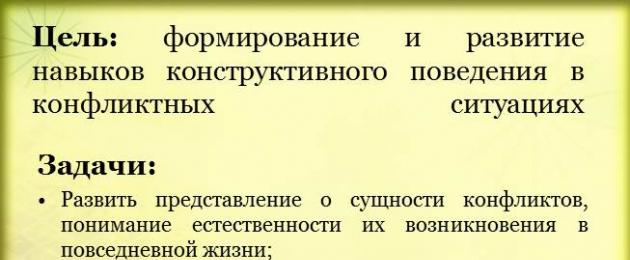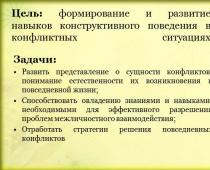Slide 2
Game "Tower"
- Task: build a tower from the proposed material.
- The main condition: the tower must be stable.
- Time for the entire game: 10 minutes. The group first discusses how to build the tower and then builds in silence. 1-3 minutes – project defense.
Slide 3
The emergence of a conflict
Slide 4
Components of a conflict situation:
- participants in the conflict (opponents);
- subject of conflict.
Slide 5
Types of conflict
- intrapersonal;
- interpersonal;
- between the group and the individual;
- intergroup conflict.
Slide 6
Test “Are you a conflict-ridden person?”
- If you often behave exactly as stated in the sentence in a conflict situation, then give 3 points; from time to time – 2 points; rarely – 1 point.
Slide 7
- I threaten or fight.
- I try to understand the enemy’s point of view and take it into account.
- I'm looking for compromises.
- I admit that I am wrong, even if I cannot completely believe it.
- I avoid the enemy.
- I wish you to achieve your goals no matter what.
Slide 8
7. I'm trying to figure out what I agree with and what I absolutely don't agree with.
8. I compromise.
9. I give up.
10. Changing the subject.
11. I persistently repeat one phrase until I achieve my goal.
Slide 9
12. I’m trying to find the source of the conflict, to understand where it all started.
13. I will give in a little and thereby push the other side to make concessions.
14. I offer peace.
15. I'm trying to make a joke out of everything.
Slide 10
Processing test results:
- Sum up the answers by group:
“A”: under numbers 1, 6, 11.
“B”: under numbers 2, 7, 12.
“B”: numbered 3, 8, 13.
“G”: under numbers 4, 9, 14.
“D”: under numbers 5, 10, 15.
Slide 11
Interpretation:
- “A” is a tough style of resolving conflicts and disputes. These people stand their ground to the last, defending their position. This is the type of person who considers himself always right.
Slide 12
- "B" is a democratic style. These people believe that it is always possible to reach an agreement; during a dispute, they offer an alternative and look for a solution that satisfies both sides.
Slide 13
- "B" is a compromise style. From the very beginning, a person is ready to compromise.
Slide 14
- "G" is a soft style. A person destroys his opponent with kindness, readily adopts the enemy’s point of view, abandoning his own.
Slide 15
- “D” is a fading style. A person’s credo is to leave in a timely manner, before a decision is made. Strives not to lead to conflict and open confrontation.
Slide 16
Heuristic game
- “The Art of Conflict Resolution.” The goal of the game is to develop the ability to get out of a conflict situation based on correct conflict resolution
To use presentation previews, create a Google account and log in to it: https://accounts.google.com
Slide captions:
Teacher-psychologist Baichorova M.B. How to avoid conflict?
Classroom objectives 1 2 3 Clarify the concept of conflict Expand the understanding of the main types and causes of conflicts Get acquainted with various ways to resolve conflict situations
Before you speak, count to ten, Before you offend, count to a hundred, Before you hit, count to a thousand. Ancient folk wisdom
Individual work 1 2 Select association words for the word “conflict” On a sheet of paper write one conflict in which you were a participant Associative series Situational workshop
Psychological test Sociological survey Develop in yourself Text See in others determination - 46%, endurance - 30% willpower - 30% tolerance - 12%, goodwill - 10% kindness - 50% honesty - 30% sympathy - 22% tolerance - 16 % generosity - 12%
About the definition of the word “conflict” Conflict (according to the explanatory dictionary) is a difficult-to-resolve contradiction associated with confrontation and emotional experiences. Conflict (in literature) is a contradiction between characters, characters and circumstances, different aspects of character. Conflict (in psychology) is a lack of agreement between two or more parties - individuals or groups. Conflict (in corporate ethics) is a contradiction due to a lack of agreement, which leads to a transformation of relationships
Clash of individuals with different views, values, character traits Personal doubts of a person, dissatisfaction with oneself and one’s life Many groups between which conflicts can arise Types of conflicts Intrapersonal Interpersonal Intergroup
Increasing conflict Respect for each other decreases, tension increases Aggression Opposition Disagreement Gap Dissatisfaction Humiliation
Harm of conflicts Human dignity suffers For 1 minute of conflict 20 minutes of subsequent experiences Physical health suffers Mood deteriorates, everything falls out of hand
Mini-test They called you names. What's your reaction? a) I’ll get off with a joke (I bow defiantly and thank you for the “good” words) b) I’ll thank you in kind (I’ll call you names) c) I’ll complain to the elders www.themegallery.com
Ways to resolve conflict Hard Neutral Soft Destructive threat, violence, rudeness, humiliation, getting personal, breaking relationships Ignoring avoidance of solving the problem Constructive humor, concessions, compromise, cooperation, awareness of the positions of the parties
Ways to resolve conflict adaptation Avoidance strategy Opportunity strategy Cooperation strategy Strategy
Results of the conflict Victory - defeat Victory - victory One side is satisfied, but the other is not Defeat - defeat Both sides are not satisfied with the result Both sides come to an agreement
Conflict Management Rules B E C D A Don't interrupt. Listen Don't make assumptions Don't get personal or insulting Offer multiple solutions to the conflict End on a positive note
Slide 1
Workshop for teachers
"Ability to resolve conflict situations"
Municipal Educational Institution of Children's Education "Center for Children's Creativity in Balashov, Saratov Region"
Prepared by: educational psychologist Kalashnikova O.A.
Slide 2

Goal: formation and development of skills of constructive behavior in conflict situations
Objectives: To develop an understanding of the essence of conflicts, an understanding of the naturalness of their occurrence in everyday life; Promote the acquisition of knowledge and skills necessary to effectively resolve problems of interpersonal interaction; Practice strategies for resolving everyday conflicts
Slide 3

Conflict is a clash of interests, confrontation, the desire to acquire values by infringing on the interests of others.
Large emotional costs Deterioration of health Decreased performance Promotes the acquisition of new information Relieves tension Stimulates positive changes Helps clarify relationships
Slide 4

Exercise “Apple and Worm”
Slide 5

You need to find a solution to the conflict that takes into account the interests of all parties as much as possible. What is the best way to resolve conflicts? What should parties to the conflict take into account?
Slide 6

Compromise -
a solution when each side makes partial concessions for common convenience.
Compromise is possible if both sides show a desire to resolve the conflict peacefully

Cooperation is an activity based on solving problems according to the principle “It’s not me against you, but us against the problems.”
Game “The Tale of the Three” Task: develop a general solution - what color to paint the fence A - blind, but hears and speaks B - deaf, but can see and move C - paralytic, he sees and hears everything, but cannot move
Slide 8

Ways to get out of a conflict situation
Compromise - achieving “half” benefit for each party Cooperation - a strategy that allows taking into account the interests of both parties Competition - involves focusing only on one’s own interests, completely ignoring the interests of the partner Avoidance is characterized by a lack of attention to both one’s interests and the interests of the partner Adaptation involves increased attention to the interests of another person to the detriment of one’s own
Slide 9

Exercise “Styles of getting out of conflict”
Assignment: You need to write a letter to Dunno from Znayka denying him a flight to the Moon, in the style of behavior in a conflict that you came across
Slide 10

Conclusions:
Disagreements turn into conflict when the parties do not show flexibility Conflicts are resolved peacefully when the parties are willing to make concessions It is often difficult to find a solution that suits everyone, but this is the only way to resolve the conflict
Slide 11

Parable "Labyrinth"
One day, a teacher took his student to a park with a labyrinth and told him to find the exit. The student got lost in the maze all day and all night, could not find a way out, despaired and fell asleep tired. In the morning the teacher found him, woke him up and told him to follow him. Coming out of the labyrinth, they climbed the mountain, to the very top. There the labyrinth was clearly visible. Look down! – said the teacher. “Can you find the path leading out of the labyrinth?” It is not difficult! You just need to take a closer look,” the student answered.
The student remembered the route and confidently walked through the labyrinth without ever getting lost. “The lesson you learned today concerns one of the main secrets of the Art of Living,” the teacher said when he met the student.
The further you move away from the situation, the higher you rise above it, the larger the surface your gaze covers, the easier it is to find the right solution.
Description of the presentation by individual slides:
1 slide
Slide description:
Description of the presentation by individual slides:
“Those who cannot cook soup make porridge.” Have you ever made porridge?
2 slide
Description of the presentation by individual slides:
The topic of the class hour is “Conflicts. How to overcome them? Conflicts are the norm of life. If there are no conflicts in your life, check if you have a pulse? C. Lixon.
Description of the presentation by individual slides:
Test to determine the conflict potential of the PPP. They avoid conflicts, but still go for them. They are consistent in conflicts and strive to bring them to resolution. Carefully correlate the goal with the means. Not supporters of conflict resolution at any cost. First they think about actions, then they make decisions. Show a lack of flexibility. PPPL. They try to avoid conflicts. They prefer to resolve them by any means. They can often abandon their previous position. They can make decisions quickly. Quite flexible, but not always consistent. Very resourceful in resolving conflict. PPLP. They do not like to conflict, but do not avoid conflicts. They enter them willingly. They behave freely and resourcefully. They resort to humor and find unconventional ways to resolve conflict situations. They don't always bring their plans to completion.
5 slide
Description of the presentation by individual slides:
Test for determining the conflict level of PPLL. Avoid conflicts. But if they encounter them, they behave firmly. Decisions are made after serious deliberation or consultation with intermediaries and loved ones. Touchy, somewhat vindictive. They never initiate clashes. Ready to make concessions. External softness is combined with internal hardness. PLPL. Very noticeable aversion to conflict. Constant desire to get out of it. Attempts to smooth over and blur the conflict. A way out of the conflict can be achieved by abandoning one’s own demands. Decisions are made by succumbing to emotional rather than rational states. For them, it is better not to enter into conflict than to get out of it. Most often they come out with a loss of their own interests and do not find ways to justify their actions. They strive to make decisions after discussing the situation with one of their experienced trusted friends or relatives.
6 slide
Description of the presentation by individual slides:
PLPP. Ready to enter into conflict. They clearly understand their interests and find the most rational ways to protect them. They calculate their capabilities well. When resolving a conflict, means are not always taken into account. They don't refuse to compromise. They are willing to enter into conflict. They often initiate it. They exaggerate when their interests dominate. In conflict they feel confident and comfortable. Sometimes they themselves can provoke a conflict, but not so much because they cannot do without it, but for the purpose of self-affirmation. PLLP. They don't like conflicts. Easy character. They tend to exaggerate their own and underestimate others' capabilities. They understand the situation quickly and well. Many friends. They react emotionally to events, but make fairly thoughtful decisions. They strive to see them through to completion, but do not rule out compromises, possibly at the expense of abandoning some requirements. The goal is not always commensurate with the means of achievement. They find unexpected solutions. They act flexibly but consistently. They listen to advice.
7 slide
Description of the presentation by individual slides:
PLLL They willingly enter into conflict. They often initiate it. They exaggerate their own capabilities, but in case of failure they do not retreat. Not inclined to compromise. They act deliberately and consistently in a conflict. The conflict is stopped only if their demands are met. The means are not always commensurate with the goals. A favorite technique is “psychological attack.” They act on their own initiative and do not really like to consult or listen to other people's advice. BOB. They avoid conflicts and feel insecure in conflict situations. They show great flexibility in their resolution. Achieving goals is correlated with real means. They are inclined to compromise and are ready to give up protecting part of their interests. The decision is made more emotionally than after serious consideration. They tend to listen to advice, but do not always follow it. There is a tendency to exaggerate one's own capabilities.
8 slide
Description of the presentation by individual slides:
LPPL. Avoid conflicts. But in cases where they consider their interests to be affected, they enter into conflict without much hesitation. Hold a firm position; they are not very inclined to compromise. They can turn to the help of intermediaries, but they make decisions on their own. Issues of self-affirmation are in the background. In the foreground are the interests of the business. LPLP. They consider conflicts inevitable and boldly go to their resolution. In conflicts they firmly achieve their goals. When achieving goals, they do not take the means into account. Sometimes great importance is attached to insignificant, secondary parties to the conflict. They are not inclined to compromise if they do not solve all the assigned tasks. They may create the appearance of concessions, but the internal position remains unchanged. The rational side prevails. They are secretive and not inclined to seek advice, although outside help is not excluded.
Slide 9
Description of the presentation by individual slides:
LPLL. Internally aggressive. They are constantly looking for a reason for conflict. They are not always guided by essential points. Conflict is covered up by external softness. Consistent in achieving goals. The line of conduct is skillfully carefully calculated. They are not inclined to compromise, regardless of the satisfaction of their own interests. They show great flexibility and ingenuity in resolving conflicts from their own positions. Often the interests of the case cannot be separated from the internal psychological position. LLPP. Avoid conflicts. They prefer to resolve controversial issues peacefully. They are ready to give up protecting their own interests, but consistently protect the interests of others. They always strive to combine the goal with the appropriate means. Their strongest side is the desire to prevent conflicts or nip them in the bud.
10 slide
Description of the presentation by individual slides:
LLPL. They strive to avoid conflict, although they do not know how to prevent it. Very prone to compromise. They give in to the demands of the conflicting parties if the enemy turns out to be strong. However, they show intransigence towards the weaker. They cannot correctly calculate their strengths and tend to exaggerate the enemy’s strengths. Unable to weave a thread of intrigue. They willingly listen to the advice of others and follow their recommendations. They tend to hide the presence of a conflict situation, sincerely believing in its absence. Not principled enough. LLLP. They do not avoid conflicts, although they rarely initiate them. They poorly think through their line of behavior in resolving conflicts and are more guided by emotions. In conflicts they act boldly and decisively, but make rash decisions. Prone to compromise. They clearly think through the possible consequences of the conflict and strive to prevent them. They often initiate compromise. They deeply experience the undesirable consequences of conflicts.
11 slide
Description of the presentation by individual slides:
LLLLL. Conflicts are avoided. They are distinguished by their great ability to prevent them. However, when taking part in conflicts, they know how to impress the enemy, using the technique of demonstrating non-existent capabilities. They know how to exploit the weaknesses of the other side. They calculate well the possible consequences of a conflict and know how to adjust their behavior in a timely manner. Stubborn, secretive.
12 slide
Description of the presentation by individual slides:
What is conflict? Conflict is a clash, a contradiction that gives rise to hostility, fear, and hatred between people.
Slide 13
Description of the presentation by individual slides:
Conflicts are the fear of at least one party that its interests are being violated, ignored, or infringed upon by the other party. William Lincoln
Slide 14
Description of the presentation by individual slides:
For a conflict to arise, it is enough: Two people Two points of view The subject of the dispute
15 slide
Description of the presentation by individual slides:
Conflicts can be: Within a person (associated with contradictions between “I want”, “can” and “need” in a person) Between individuals Within a group Between groups Within an organization
16 slide
Description of the presentation by individual slides:
There are different types of conflicts: Conflict of goals - the situation is characterized by the fact that the parties involved have different views of the desired state of the object in the future. Conflict caused by the fact that the parties involved differ in views, ideas and thoughts on the problem being solved. Sensory conflict that occurs when the participants have different feelings and emotions underlying their relationships with each other as individuals.
Slide 17
Description of the presentation by individual slides:
What would you do? Situation 1. You want to go out for a longer walk today, but your parents don’t allow it, a conflict situation has arisen between you. Situation 2. During one of the breaks, a high school student approached you, asked to look at your mobile phone and started calling from it without permission, which is why a conflict arose. Situation 3. You like to watch loud music, but your parents prefer silence in the house, and you often have conflicts with them about this. Situation 4. Before going to bed, you often look through your favorite magazines. This activity captivates you so much that you cannot tear yourself away and finally go to bed. Because of this, you have conflicts with your parents.
18 slide
Description of the presentation by individual slides:
Slide 19
Description of the presentation by individual slides:
A – tough type of conflict and dispute resolution. You stand your ground until the last moment, defending your position. You want to win. This is the type of person who always thinks he is right.
20 slide
Description of the presentation by individual slides:
B – democratic style of behavior. You always strive to reach an agreement. During a dispute, you try to offer an alternative, looking for solutions that would satisfy both sides.
21 slides
Description of the presentation by individual slides:
22 slide
Description of the presentation by individual slides:
G – soft style. You will “destroy” your opponent with kindness. You readily take the enemy’s point of view, abandoning your own.
Slide 23
Description of the presentation by individual slides:
D – outgoing style. Your credo is “leave on time.” You try not to aggravate the situation, not to lead to an open clash.
24 slide
Description of the presentation by individual slides:
What should you do to avoid conflict? Adaptation Avoidance Rivalry Cooperation (compromise) Sacrificing one's own interests for the sake of the interests of another Avoidance of decision-making The desire to achieve one's own at the expense of another Search for a solution that suits both parties Peaceful, compliant people People who are unsure of themselves People who are confident, aggressive, ambitious Strong, mature, confident people
25 slide
Description of the presentation by individual slides:
What is the harm of conflicts? Firstly, human dignity suffers from conflicts. Secondly, for every minute of conflict there are 20 minutes of subsequent experiences, then the work does not go well, and in general, everything falls out of hand. Thirdly, physical health suffers - the nerves, heart, and blood vessels are affected. Therefore, it is imperative to learn how to prevent such conflicts.
26 slide
Description of the presentation by individual slides:
The Golden Rule of Communication: Always treat others as you would like others to treat you.
Slide 27
- In contact with 0
- Google+ 0
- OK 0
- Facebook 0








